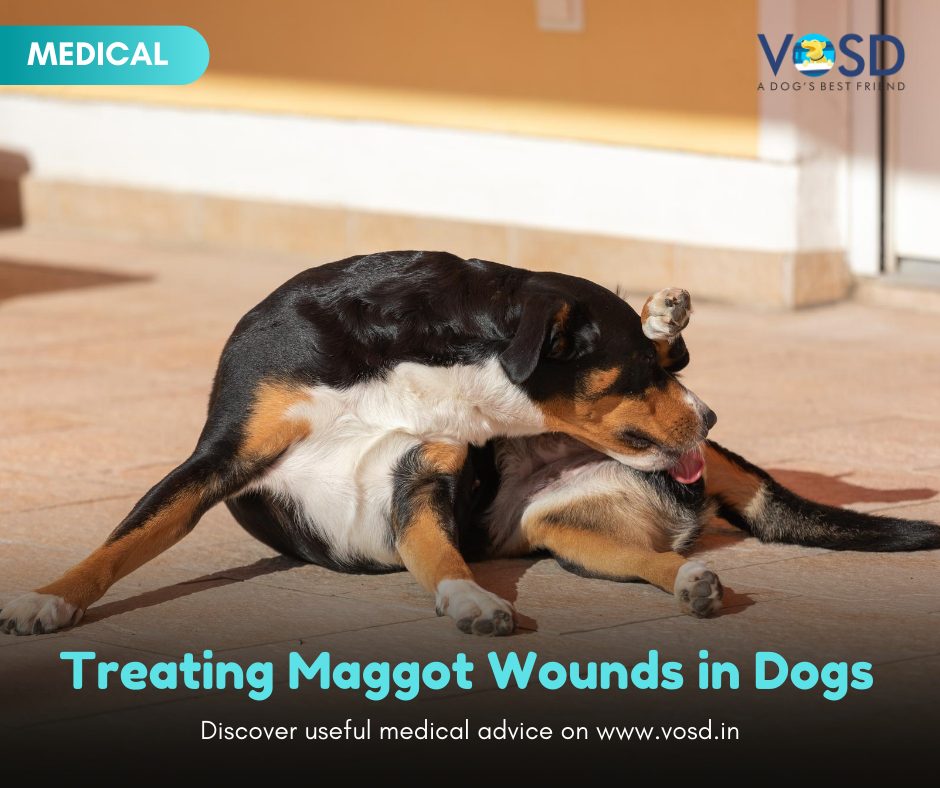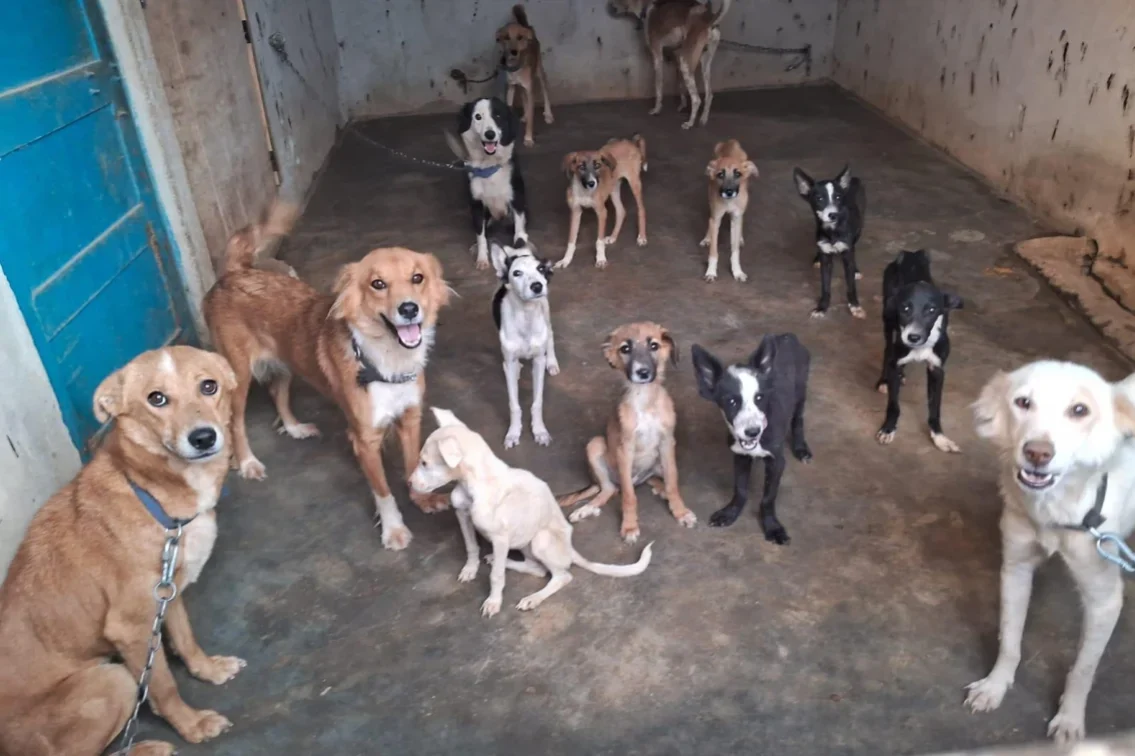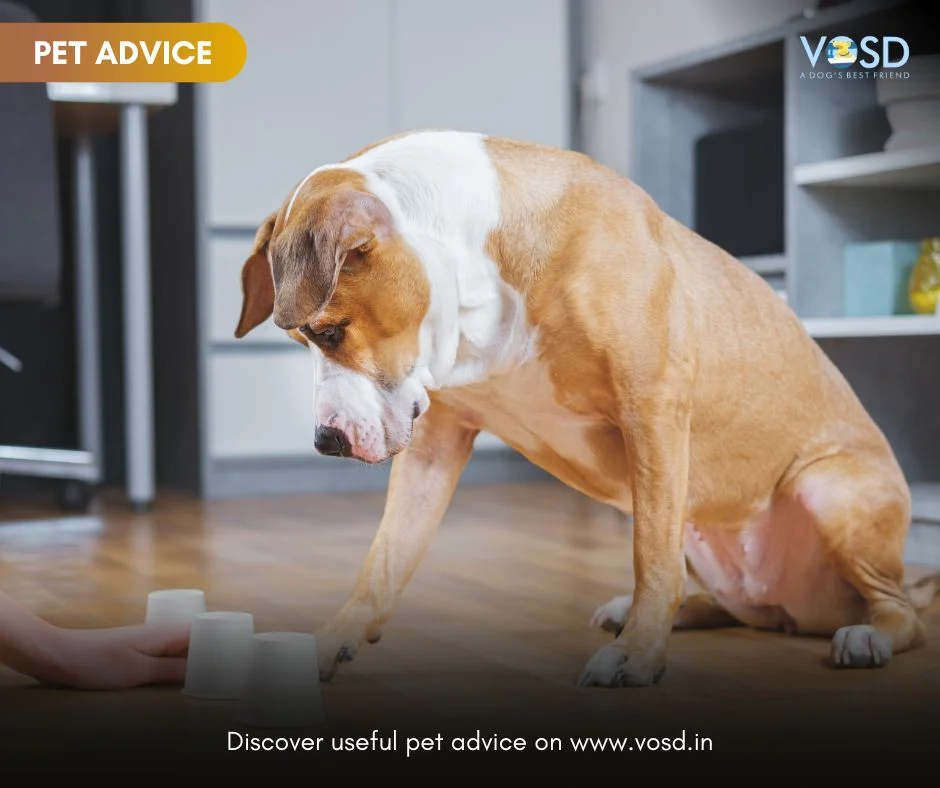Maggot wounds are very common. The good news is that unless a large part of the dog’s body or organs have been eaten away they are very easy to heal. Unfortunately, any number of ‘home’ treatments complicate situations for dogs whereas actual treatment is straightforward and usually requires no hospitalization.
What are maggots and how do they get to dogs?
A puncture wound on a dog’s skin, especially a place he can’t lick, can easily turn into a maggot wound. The most common places are the head or the back of the head, the paws, the tail or base of the tail, etc. Puncture wounds could happen because of injury or even because of excessive scratching. Dogs will lick any puncture wound but if they can’t and if a fly can sit on it, it will lay eggs and the larvae become the maggots we see. The problem is that eggs hatch in thousands and they have a voracious appetite. Essentially the larvae are eating the dog alive and they can do it quickly.
The good thing is the maggots also keep the wound aseptic. The tissue has no bacterial load and it heals VERY FAST. All you need to do is kill the maggots, prevent recurrence, and avoid damaging the tissue.
A Sneak Peek into Our Charity for Dogs – VOSD has rescued 8,000+ dogs, given 250,000+ state-of-the-art free treatments
How do you treat a maggot wound?
Before treatment, you need to identify the wound. Even if it is not exposed, you can tell it is a maggot wound by its:
- Smell: Maggot wounds have a very strong putrid smell and
- Inflammation around the area: The body tries to defend against the advance of tissue being eaten alive and causes massive swelling.
The most commonly used stuff that is poured inside a maggot wound includes turpentine, chloroform, tincture, even petrol. DON’T. These are painful substances for the dog and have a little immediate effect on the maggots. If you see maggots alive in a wound follow these steps:
Dressing the wound
Get yourself a vial of ivermectin injection (available in vet shops). Take a 2/5ml syringe and draw the liquid in it. Ivermectin is a very viscous liquid so is it NOT easy to draw: to draw 2 ml say, push 2 ml of air and then draw.
Discard the needle, use only the syringe to squirt the ivermectin carefully ‘inside’ the wound. After this step do not do anything for half an hour other than cover the wound if you can. Ivermectin kills maggots on contact but it needs to seep in thoroughly.
After half an hour, use tweezers to take out the dead maggots.
Flush the wound with saline (RL) then with povidone iodine (betadine). Pat dry. Dress the wound with an antibiotic and bandage if required. If the dead maggot is left inside (they can be very small- they are readily absorbed by the body. But pay attention that no live maggots are left in. (See next step)
Check wound every second day- do not wash and dress every day since the tissue needs time to regenerate.
Over the period of healing of the wound, repeat the last two steps.
Oral/injectible medication, post-dressing
Put the dog on a course of Prednisalone (Wysalone) which is a steroid that will reduce inflammation and make up for the extensive loss of platelets fighting the infection. 10 mg/20 kg is a sufficient dose. Do this for 5 days.
The antibiotic could be plain amoxillin or amoxillin + potassium clavunate (which is a fifth-generation broad spectrum antibiotic. This is a human medicine available at drug stores/chemists). 325 mg for 20 kg is sufficient for five days.
The medicines described above can be given as injectibles as well and might be a better course of action if you can do so.
Nutrition
Put the dog on a high protein nutritious diet. While ‘Recovery’ and such brands are recommended, just boiled chicken or boiled eggs are great proteins by themselves.
You may add oral iron supplements such as Haemup to combat anemia.
Additional support
Remember these instructions are to give you the first line of defence to support the dog in your care and any situation may differ on diagnosis after a physical inspection and a CBC + Renal/Liver function test.
Frequently Asked Questions (FAQ)
1.Why do maggots appear in dogs?
Open or puncture wounds in dogs can be breeding spaces for maggots if the wound is not treated immediately. Even though some wounds can be licked by dogs, other areas that are mostly out of reach for a dog can get infected by maggots. These include the tail, the paws, the front, and the back of the heads.
In general, maggots in dogs are formed when a fly or insect lays eggs that become larvae and multiply extensively. This means that they have the capacity of eating the dog alive, gradually. The wound can be treated by killing the maggots and preventing recurrence of the same.
2. Are maggots harmful to dogs?
Maggots have a huge appetite and can multiply rapidly after settling on a puncture wound in a dog. These maggots in the wounds on dogs slowly eat the flesh alive, and thus need to be treated immediately. However, since they don’t contain any bacteria, they do not promote swelling or spread the wound. Further, they also avoid infections in the affected area of injury by keeping the wound aseptic. Hence quick treatment of maggot wounds can lead to quick healing for the dog.
3. Can turmeric kill maggots?
Not sure whether maggots can kill a dog? In most cases, it never happens especially when you take precautionary measures on priority. Turmeric (a common ingredient in most Indian households) is an all-in-one antiseptic that benefits both the humans and the animals.
You must consult your vet to remove any existing maggots from the wound – do not cause damage to the dog with haphazard treatment. Cleaning of the area with betadine lotion and any other suitable antiseptic medicine or ointment suggested by the veterinarian can further minimize the suffering.
However, applying the right amount of turmeric can again help you control the maggot infestation in the wound present on your dog’s body. Usually, treating with a pinch of turmeric can help the situation till a proper medical procedure is done to remove the maggots and heal the wound. This super ingredient is also known to suffocate any existing maggots to prevent them from multiplying in number.
4. How to tell if your dog has maggots?
You can easily identify maggot wounds in dogs by closely inspecting the area. The continuous gnawing of maggots and their spread inside a wound on the body can further add to the discomfort of your pet dog.
A maggot wound can be determined through the following cues:
- A strong pungent smell should be coming out of your dog’s coat, even if you cannot see the maggots with your naked eyes
- Any wound caused in the body will be surrounded by inflammation as it’s the body’s way of defending itself
In case you find maggots on your pets’ body, you must implement necessary precautions to remove them, stop them from multiplying, and healing the wounded area to prevent further infection.
5. Do Maggots multiply?
Maggots are the result of eggs that transform into larvae and spread rapidly in a dog’s body. Flies and insects lay them on an unhealed, puncture wound on the dog’s body. According to experts, the maggots in dog wounds eat away the flesh of the dog very quickly and can multiply if left untreated.
Your veterinarian will recommend a spray or ointment to remove the maggots gradually. Once that is done, you can clean the wound area to provide some comfort to your pet. To prevent the recurrence of maggots, make sure that any wound on your dog’s fur is treated immediately, especially if formed on areas that can’t be reached by the pet.
The information contained in VOSD Vet Advice™ is not intended nor implied to be a substitute for professional medical action which is provided by your vet. You assume full responsibility for how you choose to use this information. For any emergency situation related to a dog’s health, please visit the nearest veterinary clinic.





